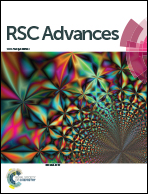The function of oxybuprocaine: a parachute effect that sustains the supersaturated state of anhydrous piroxicam crystals†
Abstract
Polymers have been recognized to have the function of sustaining the supersaturated state of drugs. This function has been widely studied because it will improve the absorption of poorly water-soluble drugs. However, clarifying the mechanism of this sustaining pharmaceutical effect (parachute effect) on the supersaturated state as a result of polymers is remains a task. We have found that oxybuprocaine, which is a small molecule, has a parachute effect on the supersaturated state (due to an anhydrate-to-hydrate transformation) of piroxicam-anhydrate in the aqueous phase. We consider that oxybuprocaine controls the environment of the solution and the network of polymers is unnecessary. Therefore, oxybuprocaine not only becomes a clue for elucidating the essential mechanism of the parachute effect of polymers but also enables us to rationally propose a new type of solubilizer.



 Please wait while we load your content...
Please wait while we load your content...